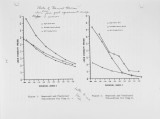| Title |
A Method For Extending Viscosity Prediction Formulas |
| Creator |
Annen, K.; Gruninger, J.; Stewart, G. |
| Publisher |
University of Utah |
| Date |
1983 |
| Spatial Coverage |
Akron, Ohio |
| Abstract |
Formulas for the prediction of coal slag viscosity and fouling potential are widely used in the boiler industry for the design of boilers and the specification of suitable coals. These formulas are based on the overall composition of the coal ash and are valid for temperatures at which the slag is entirely liquid (i.e., above the liquidus temperature). The extension of viscosity formulas to temperatures below the liquidus temperature can be performed by using a chemical equilibrium code to calculate the composition of the liquid phase to be used in a formula, applying the formula to obtain the viscosity, and then correcting the predicted liquid viscosity for the presence of solids in the liquids. This method has been used to extend the viscosity predictions to temperatures below the liquidus temperature. Results of the extended viscosity method are very encouraging. For slags which are characterized by a pronounced temperature of critical viscosity, the extended formula agrees very well with measured viscosity data. For slags which do not exhibit critical viscosity behavior, the extended formula predicts the qualitative behavior well, but is quantitatively less accurate than the formula prediction based on the initial slag composition. Approaches for improving the quantitative accuracy of the extension methodology include expanding the thermodynamic data base of the ideal solution model and the use of an improved viscosity prediction formula. |
| Type |
Text |
| Format |
application/pdf |
| Language |
eng |
| Rights |
This material may be protected by copyright. Permission required for use in any form. For further information please contact the American Flame Research Committee. |
| Conversion Specifications |
Original scanned with Canon EOS-1Ds Mark II, 16.7 megapixel digital camera and saved as 400 ppi uncompressed TIFF, 16 bit depth. |
| Scanning Technician |
Cliodhna Davis |
| ARK |
ark:/87278/s61n83n5 |
| Setname |
uu_afrc |
| ID |
187 |
| Reference URL |
https://collections.lib.utah.edu/ark:/87278/s61n83n5 |













